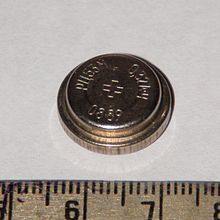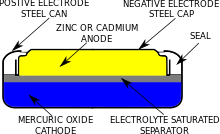
Back خلية الزئبق Arabic Pila de mercuri Catalan Quecksilberoxid-Zink-Batterie German Batería de mercurio Spanish باتری جیوهای Persian Pile au mercure French मर्करी बैटरी Hindi Pila a mercurio Italian 水銀電池 Japanese മെർക്കുറി ബാറ്ററി Malayalam

A mercury battery (also called mercuric oxide battery, mercury cell, button cell, or Ruben-Mallory[1]) is a non-rechargeable electrochemical battery, a primary cell. Mercury batteries use a reaction between mercuric oxide and zinc electrodes in an alkaline electrolyte. The voltage during discharge remains practically constant at 1.35 volts, and the capacity is much greater than that of a similarly sized zinc-carbon battery. Mercury batteries were used in the shape of button cells for watches, hearing aids, cameras and calculators, and in larger forms for other applications.
For a time during and after World War II, batteries made with mercury became a popular power source for portable electronic devices. Due to the content of toxic mercury and environmental concerns about its disposal, the sale of mercury batteries is now banned in many countries.[2] Both ANSI and IEC have withdrawn their standards for mercury batteries.

- ^ Salkind, Alvin J.; Ruben, Samuel (1986). "Mercury Batteries for Pacemakers and Other Implantable Devices". Batteries for Implantable Biomedical Devices. Springer US. pp. 261–274. doi:10.1007/978-1-4684-9045-9_9. ISBN 978-1-4684-9047-3.
- ^ Cite error: The named reference
Hunter_1999was invoked but never defined (see the help page).
© MMXXIII Rich X Search. We shall prevail. All rights reserved. Rich X Search